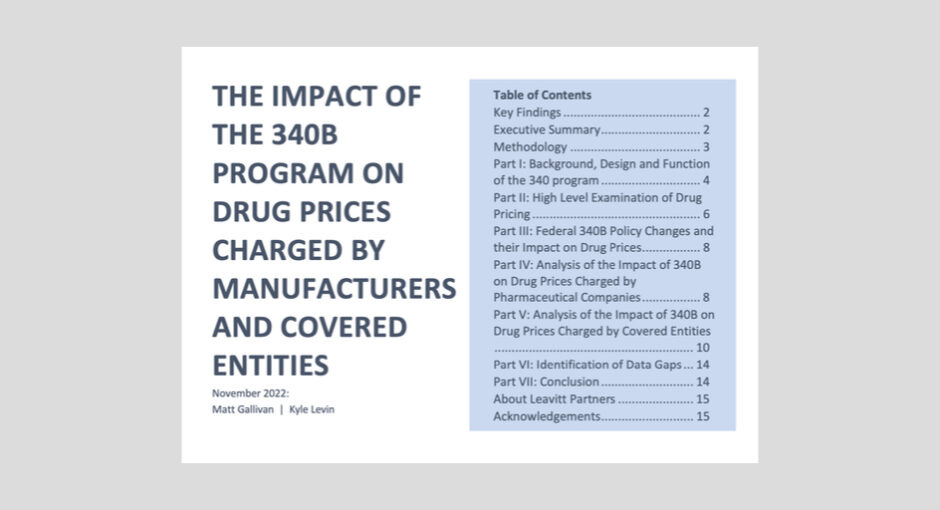Lack of data makes it hard to assess the 340B program’s overall impact on drug prices charged by pharmaceutical companies and covered entities, a new study by healthcare consulting and lobbying firm Leavitt Partners concludes.
“We found compelling evidence that the 340B program does impact how pharmaceutical manufacturers set list prices for drugs and the drug prices covered entities charge patients and various payors,” the researchers said in the Dec. 1 white paper.
However, they added, “Measuring the magnitude of the 340B program’s impact on drug pricing decisions by manufacturers and covered entities have been more challenging. This has been due to constraints on the availability of data, as well as a generally limited amount of comprehensive research into this subject area.”
Leavitt Partners was founded by Michael Leavitt, who served as U.S. Health and Human Services Secretary and Environmental Protection Agency Administrator for President George W. Bush and also served as the Republican governor of Utah for three terms.
The authors of the study, Matt Gallivan and Kyle Levin, said it based the study on a review of data including government reports, peer-reviewed journal articles, white papers, and news articles, and on interviews with 10 experts representing the perspectives of covered entities and drug manufacturers.
Regarding 340B’s impact on manufacturer list prices, the white paper noted that, while existing research suggests a link, “studies have sometimes reached conflicting conclusions as to whether the program leads to higher or lower list prices,” adding, “While several interviewees expressed a belief that the 340B program impacts manufacturer list prices, none could offer a conclusive assessment of the scope of such an impact.”
In fact, drug makers consider multiple factors when setting a drug’s list price, including product portfolio, market position, payer mix, and macro-economic conditions and also factor in all forms of discounts in addition to those related to 340B, the study found. Also, a drug’s list price doesn’t always reflect what a patient ultimately pays for the drug, the paper said.
“Given that all of these factors come into play simultaneously, it is virtually impossible to objectively disentangle a single factor in a manner that allows us to measure its sole impact on increases in prices or higher launch prices,” the white paper said.
Still, “Researchers have posited that the 340B program may contribute to rising drug prices due to manufacturers shifting some of the perceived revenue losses by increasing drug prices for other payers,” the paper said.
The study also noted a significant data gap in the area of covered entity pricing. “Sufficient data on prices covered entities charge for 340B drugs is not publicly available, making it nearly impossible to assess how the 340B program impacts covered entity pricing decisions as a whole,” the researchers said.
The study found that, while some 340B covered entities charge patients and payers above the 340B discounted price to generate savings, a lack of available information made it hard to track how much of those savings were being used to cut costs for low-income patients or increase their access to services.
“Savings providers generate through the program are unlikely to be passed on directly to patients or payers,” the researchers said. “340B program incentivizes behavior on a macro level that leads to increases in the prices charged by covered entities.”
Another problem is that spending accountability varies by type of entity, they said. “While some [340B providers] have requirements to use the discounts to advance their mission of helping low-income patients, other types of covered entities are not limited in how they account for and use the savings generated from the discounts,” the white paper said. “Our literature review found no authoritative, definitive source of data that could characterize how each type of covered entity approaches utilizing 340B savings.”
The researchers said more data are needed on the number and types of patients receiving drug discounts either through a discount card or through another means, such as charitable assistance, copay programs, or a sliding fee scale, to help clarify the 340B program’s impact on drug prices. The Arnold Foundation funded the study. The philanthropy is currently sponsoring a study by New York University researchers on the “impacts of the 340B drug pricing program on physician-administered drug prices and drug administration for a large population of privately insured patients.”


